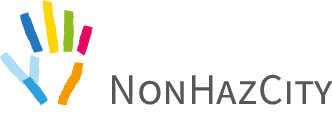Social Media Campaign – The NonHazCity Plastic Diet
3 May 2021 – 13 June 2021
A tool for reducing emissions and exposure of hazardous substances from everyday use of goods and materials at homes and workplaces in town
The plastic we use in our everyday lives can harm our health. Most plastics are mixtures of polymers that are usually obtained from fossil fuels and a cocktail of additives. Additives contribute to plastic having the desired functions of our everyday items, such as high flexibility (softeners), UV protection (UV protectors) or fire resistance (flame retardants). However, additives and residues from plastic production processes can leach out and have very negative effects on human health and the environment. Society is aware of the issues of plastic wastes on land, in oceans and dolphin bellies, and about macro- and microplastic particles. Until now, knowledge about hazardous substances in plastic materials and articles has not yet reached most people.
There have been many earlier campaigns about reducing our use of plastic. With our campaign we would like to add a new dimension. Hence, the current campaign is not focused just on reduction of plastic as such but on informed choices and safe handling in the right context.
The aim of the campaign is to foster a change in consumption and behavior: less plastics, better use – informed choice and safe handling. To reach the aim we will have 6-week information campaign with 6 different topics.
The 6 topics with focus on hazardous substances and their potential features are the following:
| Focus topic | Features | Slogan |
| Textile/ Cloth | Types of fibres – natural vs artificialHazardous substances in plastic fabricsLabels for clothHealth aspects – intake paths, possible diseases, etc | The risk on our skin! |
| Sports equipment & bathing tools | Additives used to achieve the desired properties – soft vs hard plastic Alternatives for sport equipmentTest results that show presence of hazardous substances in sports and leisure articles | Be healthy not poisoned |
| Home accessories and decorations | Natural materials in decoraton vs artificial ones (e.g., plants)Various seasonal decorations and their alternativesStorage of little things/ trinkets | Surrounded by plastics |
| Toys, children’s furniture and accessories | Play items that are not meant to be toysHazardous substances in children articlesHealth aspect – children are the most vulnerableSubstances in dust | Invisible danger for our smallest |
| Food contact materials | Plastic for storage and recycling codesTemperature and plasticCanned food | Detox your kitchen! |
| Bioplastic | why “bioplastic” is misleadingMaterials used (e.g., melamine resin in bamboo products)Climate and chemical relevanceMyth of degradation and composting | Solution or greenwashing |
The campaign will start with an overall introduction and then the focus topics – starting with textile/ cloth and ending with bioplastic – will follow. As seen from the table each focus topic will cover some or all of the following aspects:
- Materials
- Potential alternatives
- Usage
- Subsatances potentially used (input from LIFE AskREACH project)
- Health aspects
- Recycling aspect
For each focus theme, we will follow a similar schedule. We will start by introducing the problem and explaining why it is important to know about it. We then move towards more concrete steps that can guide people to actions and behaviour change in future. The general timeplan for each focus topic will use this structure:
- Day 1 – explain problem/ issue
- Day 2 – recognition (e.g., labels)
- Day 3 – feature with VIP / live action
- Day 4 – animate people to look at their homes/ surrounding & bring back as comments
- Day 5 – alternatives to use/ safer uses/ scanning with Scan4Chem (one fixed date per week),
- Day 6 – test the new knowledge (e.g., quizzes, Check(ED), etc.)
The general slogan for the campaign is: Plastics and the hidden threat to your health
The campaign obligatory hashtag is: #NonHazPlasticDiet. This hashtag we use for tracking the campaign. Additionally several other hashtags (eg plasticfree, lessplastic etc) in English and national languages can be used to have wider reach.
The one visual element to be used is: Logo “hand” with slogan
If you are interested to participate in the campaign then there are several options.
- Campaign partner – the NonHazCity campaign team will provide English language materials for the six-week social media campaign as well as other materials including games, quizzes and attactions. These can be used by campaign partners in any country and language. Each campaign partner has a certain freedom what to do, but we keep the joint structure, topical focus of the weeks and key messages.
We hope to receive statistical information from each campaign partner on the reach of their Social Media posts.
- Organisation that takes on a challenge – organisation/ institution who would like to pay more attention to hazardous substances in their premises – to raise awareness and reduce the use of hazardous substances. You can define your focus with our help and evaluate your progress. We hope that you are willing to share your experiences with others!
- Participating VIPs and influencers – you would be a face of the campaign and give it a wider reach. We will agree with you about your level or involvement including your Social Media posts and tasks you choose to implement.
In case of you would like to receive further information please contact
Baltic Environmental Forum Estonia
Kai Klein, kai.klein@bef.ee

